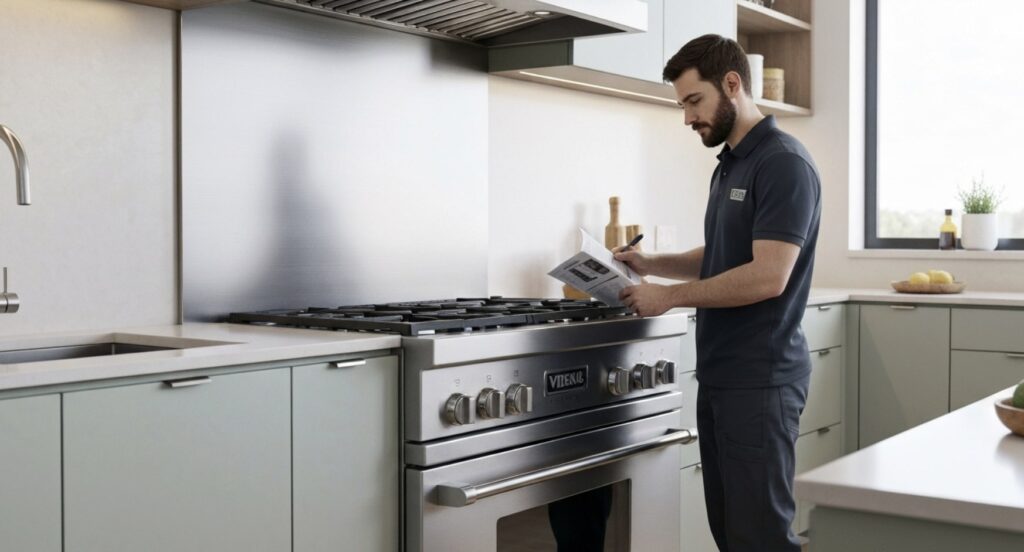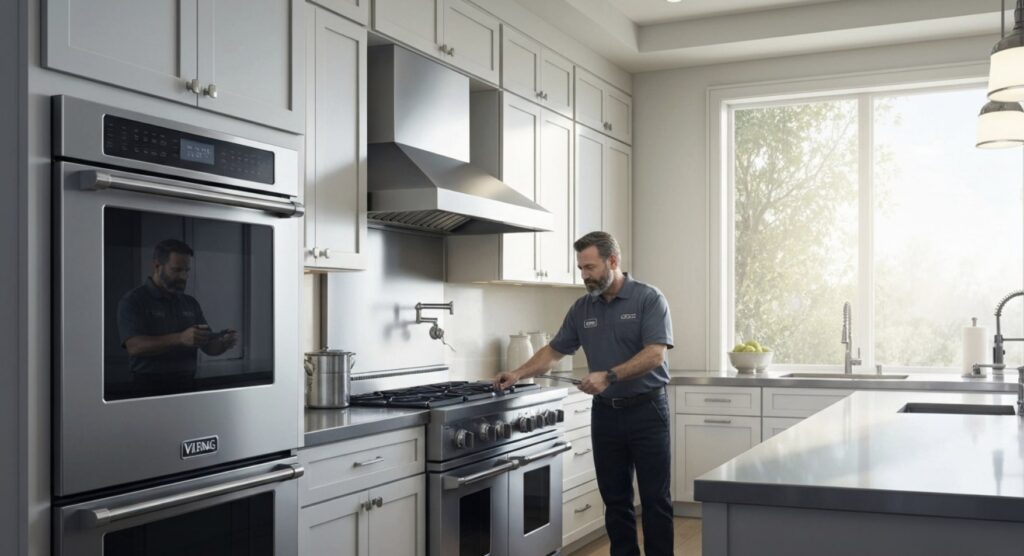Dealing with a flooded kitchen floor from an overflowing dishwasher is a nightmare for any homeowner. Before you panic or rush to get costly appliance repairs, remember this: many problems with dishwashers overflowing can be avoided. Some can even be fixed without a professional’s help. In this guide, we will explain how your dishwasher works. We will also give you step-by-step instructions on how to stop an overflowing dishwasher. This will help you avoid headaches and wet floors in the future.
Understanding Your Dishwasher’s Mechanism
Ever thought about what happens behind your dishwasher door when you press ‘start’? Your Viking dishwasher or other brand goes through different steps like filling, washing, draining, and drying to make your dishes shine. Knowing how your dishwasher works is the first step to fixing any problems, like overflow issues.
A dishwasher mainly works by moving water in and out. Water comes in, heats up, then moves through spray arms to clean the dishes. Finally, it drains out. If anything goes wrong in this process, it can cause issues like water overflow.
Key Components and Their Functions
Let’s look at this complicated appliance by breaking it down into some of its important parts:
- The Wash Tub: This is where you put your dirty dishes. It holds the spray arms and the filter at the bottom.
- The Spray Arms: These rotating arms spray water and detergent on your dishes. If they are clogged or broken, it can mess up the water flow.
- The Drain System: This system removes the dirty water after each cycle. If the drain hose or air gap gets blocked, it can cause water to back up.
- The Float Switch: This part controls the water level in the dishwasher. If the float switch does not work properly, it can cause overfilling and overflow.
Now that we know some of the key parts, let’s see how they all work together to make the dishwasher function.
How Water Circulates in a Dishwasher
The process starts with the water inlet valve. This valve lets water from your home’s plumbing enter the dishwasher. The float switch checks the water level inside the tub. It tells the valve to shut off when the right level is reached.
Then, the heating element warms up the water to the right temperature. After that, the wash pump starts working. It draws water from the tub and pushes it through the spray arms. The spray arms rotate to spray the dishes with hot water and detergent. This helps clean off food crumbs.
Finally, the drain pump gets rid of the dirty water. It sends the water through the drain hose and out of your home’s plumbing system.
Beginner’s Guide to Preventing Dishwasher Overflow
Now that you understand how your dishwasher works, let’s talk about how to stop those annoying overflows.
The good news is that with some basic maintenance, you can make a big difference. By following a few easy habits, you can lower the chance of an overflow.
Tools and Supplies You Will Need
Before you start taking care of your dishwasher, grab these tools. You might already have most of them in your kitchen. This will make it a simple DIY task.
- Dish Towel or Sponge: Take a clean towel or sponge to wipe away food bits.
- A Toothbrush or Small Brush: This is good for getting into small areas and cleaning around the spray arm nozzles.
- Vinegar: Use distilled white vinegar to get rid of mineral buildup and bad smells.
Step 1: Inspecting and Cleaning the Filter
This should be the first thing on your dishwasher maintenance checklist. The filter, found at the bottom of the dishwasher, is very important. It stops food bits from blocking the drain. A blocked drain is one of the top reasons for dishwasher overflow.
To clean it, take out the filter carefully. Check your dishwasher’s manual for directions. Rinse the filter well under running water.
For tough stains, you can use a toothbrush with a gentle dish soap mix. Make sure the filter is completely dry before putting it back in the dishwasher.
Step 2: Checking and Cleaning the Spray Arms
The spray arms help spread water around in the dishwasher. Over time, food bits can block the nozzles of the spray arms. This can cause uneven water flow and even overflow. It’s important to check the holes in the spray arms for any blockages.
If you find a blockage, use a toothpick or a straightened paper clip to carefully remove it. Don’t use sharp objects as they might harm the spray arm.
After clearing it, run a short cycle with only hot water. This will help wash away any leftover debris.
Contact Viking Appliance Repair Pros for Expert Service!
Are you still experiencing issues with your dishwasher despite your best efforts? Sometimes, a persistent overflow problem requires professional attention. That’s where Viking Appliance Repair Pros comes in! We specialize in resolving all types of appliance repair issues, getting your kitchen back to working order in no time.
| Service | Description |
|---|---|
| Dishwasher Repair | Diagnosis and repair of overflow issues, leaks, drainage problems, and more. |
| Appliance Installation | Professional installation of new dishwashers, ensuring proper connections and optimal performance. |
| Preventative Maintenance | Scheduled checkups and cleaning to keep your appliances running smoothly and prevent future problems. |
Call us today to schedule a service or to learn more about our comprehensive appliance repair solutions!
Conclusion
Learning how to stop an overflowing dishwasher is essential for maintaining a functional kitchen. By following simple steps like checking and cleaning the spray arms regularly, you can prevent issues like uneven water flow and overflow. However, if problems persist, it’s best to seek professional help. Viking Appliance Repair Pros offers expert service for dishwasher repair, installation, and preventative maintenance. Don’t let dishwasher problems disrupt your kitchen routine – reach out to us today for reliable solutions!
You can also check our blog on How to Fix a Broken Dishwasher Spray Arm for more tips and solutions on dishwasher care. A well-maintained dishwasher will work better and cause fewer problems in the kitchen.
Frequently Asked Questions
How often should I clean my dishwasher filter?
To stop overflowing and keep your dishwasher running well, it is good to clean the dishwasher filter at least once a month.
What should I do if replacing the gasket doesn’t stop the overflow?
If changing the door gasket does not fix the overflow, there could be a bigger problem. It is a good idea to contact a qualified appliance repair technician to diagnose and repair it.
Is it safe to run a dishwasher if it has previously overflowed?
Before you start a dishwasher that has overflowed, make sure you find and fix the cause of the overflow. It is very important to unplug the appliance and remove any standing water near the dishwasher. This helps to keep you safe from electrical hazards.






